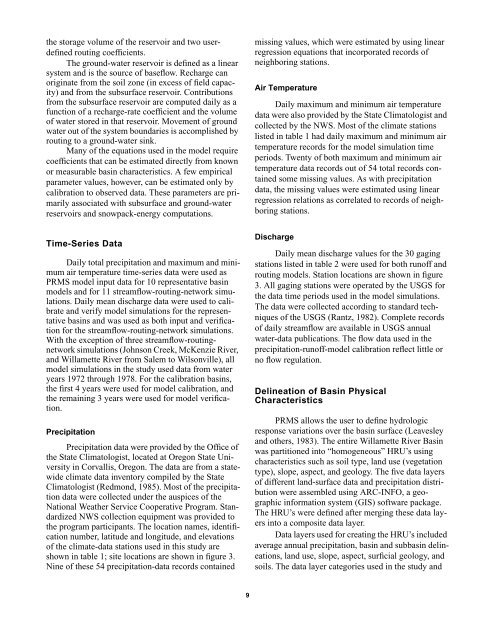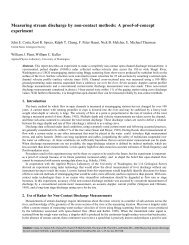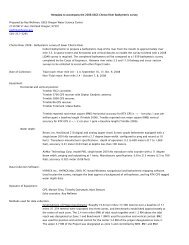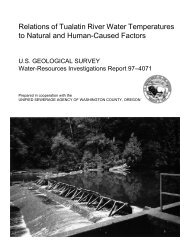Precipitation-Runoff and Streamflow-Routing Models for the ...
Precipitation-Runoff and Streamflow-Routing Models for the ...
Precipitation-Runoff and Streamflow-Routing Models for the ...
- No tags were found...
Create successful ePaper yourself
Turn your PDF publications into a flip-book with our unique Google optimized e-Paper software.
<strong>the</strong> storage volume of <strong>the</strong> reservoir <strong>and</strong> two userdefinedrouting coefficients.The ground-water reservoir is defined as a linearsystem <strong>and</strong> is <strong>the</strong> source of baseflow. Recharge canoriginate from <strong>the</strong> soil zone (in excess of field capacity)<strong>and</strong> from <strong>the</strong> subsurface reservoir. Contributionsfrom <strong>the</strong> subsurface reservoir are computed daily as afunction of a recharge-rate coefficient <strong>and</strong> <strong>the</strong> volumeof water stored in that reservoir. Movement of groundwater out of <strong>the</strong> system boundaries is accomplished byrouting to a ground-water sink.Many of <strong>the</strong> equations used in <strong>the</strong> model requirecoefficients that can be estimated directly from knownor measurable basin characteristics. A few empiricalparameter values, however, can be estimated only bycalibration to observed data. These parameters are primarilyassociated with subsurface <strong>and</strong> ground-waterreservoirs <strong>and</strong> snowpack-energy computations.Time-Series DataDaily total precipitation <strong>and</strong> maximum <strong>and</strong> minimumair temperature time-series data were used asPRMS model input data <strong>for</strong> 10 representative basinmodels <strong>and</strong> <strong>for</strong> 11 streamflow-routing-network simulations.Daily mean discharge data were used to calibrate<strong>and</strong> verify model simulations <strong>for</strong> <strong>the</strong> representativebasins <strong>and</strong> was used as both input <strong>and</strong> verification<strong>for</strong> <strong>the</strong> streamflow-routing-network simulations.With <strong>the</strong> exception of three streamflow-routingnetworksimulations (Johnson Creek, McKenzie River,<strong>and</strong> Willamette River from Salem to Wilsonville), allmodel simulations in <strong>the</strong> study used data from wateryears 1972 through 1978. For <strong>the</strong> calibration basins,<strong>the</strong> first 4 years were used <strong>for</strong> model calibration, <strong>and</strong><strong>the</strong> remaining 3 years were used <strong>for</strong> model verification.<strong>Precipitation</strong><strong>Precipitation</strong> data were provided by <strong>the</strong> Office of<strong>the</strong> State Climatologist, located at Oregon State Universityin Corvallis, Oregon. The data are from a statewideclimate data inventory compiled by <strong>the</strong> StateClimatologist (Redmond, 1985). Most of <strong>the</strong> precipitationdata were collected under <strong>the</strong> auspices of <strong>the</strong>National Wea<strong>the</strong>r Service Cooperative Program. St<strong>and</strong>ardizedNWS collection equipment was provided to<strong>the</strong> program participants. The location names, identificationnumber, latitude <strong>and</strong> longitude, <strong>and</strong> elevationsof <strong>the</strong> climate-data stations used in this study areshown in table 1; site locations are shown in figure 3.Nine of <strong>the</strong>se 54 precipitation-data records containedmissing values, which were estimated by using linearregression equations that incorporated records ofneighboring stations.Air TemperatureDaily maximum <strong>and</strong> minimum air temperaturedata were also provided by <strong>the</strong> State Climatologist <strong>and</strong>collected by <strong>the</strong> NWS. Most of <strong>the</strong> climate stationslisted in table 1 had daily maximum <strong>and</strong> minimum airtemperature records <strong>for</strong> <strong>the</strong> model simulation timeperiods. Twenty of both maximum <strong>and</strong> minimum airtemperature data records out of 54 total records containedsome missing values. As with precipitationdata, <strong>the</strong> missing values were estimated using linearregression relations as correlated to records of neighboringstations.DischargeDaily mean discharge values <strong>for</strong> <strong>the</strong> 30 gagingstations listed in table 2 were used <strong>for</strong> both runoff <strong>and</strong>routing models. Station locations are shown in figure3. All gaging stations were operated by <strong>the</strong> USGS <strong>for</strong><strong>the</strong> data time periods used in <strong>the</strong> model simulations.The data were collected according to st<strong>and</strong>ard techniquesof <strong>the</strong> USGS (Rantz, 1982). Complete recordsof daily streamflow are available in USGS annualwater-data publications. The flow data used in <strong>the</strong>precipitation-runoff-model calibration reflect little orno flow regulation.Delineation of Basin PhysicalCharacteristicsPRMS allows <strong>the</strong> user to define hydrologicresponse variations over <strong>the</strong> basin surface (Leavesley<strong>and</strong> o<strong>the</strong>rs, 1983). The entire Willamette River Basinwas partitioned into “homogeneous” HRU’s usingcharacteristics such as soil type, l<strong>and</strong> use (vegetationtype), slope, aspect, <strong>and</strong> geology. The five data layersof different l<strong>and</strong>-surface data <strong>and</strong> precipitation distributionwere assembled using ARC-INFO, a geographicin<strong>for</strong>mation system (GIS) software package.The HRU’s were defined after merging <strong>the</strong>se data layersinto a composite data layer.Data layers used <strong>for</strong> creating <strong>the</strong> HRU’s includedaverage annual precipitation, basin <strong>and</strong> subbasin delineations,l<strong>and</strong> use, slope, aspect, surficial geology, <strong>and</strong>soils. The data layer categories used in <strong>the</strong> study <strong>and</strong>9







